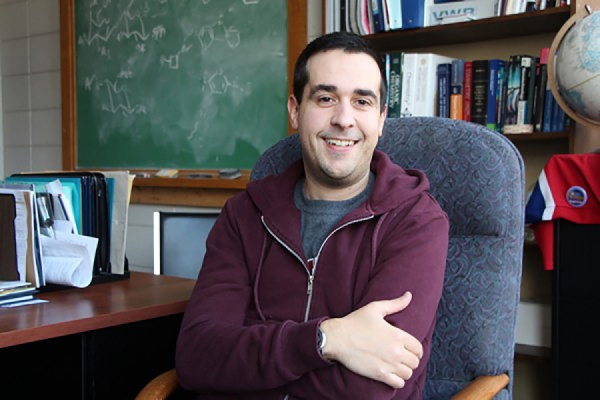 Chemistry professor Simon Rondeau-Gagné heads a research team exploring new approaches to prepare and synthesize organic semiconductors.
Chemistry professor Simon Rondeau-Gagné heads a research team exploring new approaches to prepare and synthesize organic semiconductors.
Simon Rondeau-Gagné is using the fundamental building blocks of chemistry to design soft and flexible electronics that could be used for chemical sensing and medical treatment.
An associate professor of chemistry and biochemistry, Dr. Rondeau-Gagné received a five-year $310,000 Natural Sciences and Engineering Research Council of Canada (NSERC) Discovery grant for his project “Molecular Engineering of Semiconducting Polymers for Emerging Organic Electronics.”
His team looks to add to today’s technologies by making semiconducting materials that can emulate the properties of human body.
“Integration of current electronics, mostly based on silicon, is very challenging. For example, it will always be difficult to implant a rigid device in the brain that would completely conform to its surface to create new functionalities,” says Rondeau-Gagné.
“To bridge the gap, you need soft materials and that is where we come in — my team uses chemistry to design and prepare new materials, and we control their mechanical properties so they can be adaptable to different types of environments with different shapes, sizes, and constraints.”
This funding support will further help his team to create new chemical approaches to prepare and synthesize organic semiconductors, and organic electronic devices such as sensors and transistors.
“We are looking to make the materials that house these electronics with softer, more stretchable, more robust, and self-healing properties; this next generation of electronic materials will be implantable or wearable, giving rise to a wide variety of novel technology in the health, communication, and energy sectors,” Rondeau-Gagné says.
“My lab is looking to create new material for these electronic devices and technologies because silicon cannot do it all; it has some limitations.”
The goal is not to replace silicon, says Rondeau-Gagné, but to create new materials to become complimentary to the silicon-based electronics used today, so they can access new functionality.
In the long term, Rondeau-Gagné’s team would like to design technology that can mimic the properties of skin.
“Skin is highly stretchable, soft and if you injure yourself, it heals spontaneously — we would like to confer that to our technology,” he says.
“In the aspects of bioelectronics and bio integrated electronics, we could restore human capabilities in vision, hearing, or even to help treat diseases like Parkinson’s — if we have a device that can be implanted in the brain — it all comes from the fundamental need for soft materials.”
This funding, says Rondeau-Gagné, helps his team bring these ideas from paper to the actual technology.
“My team not only synthesizes and characterizes these new materials with advanced techniques, we also fabricate our own devices — and every team member has exposure of the whole manufacturing chain of development of electronics, from the fundamental design to the integration of materials into electronic devices,” says Rondeau-Gagné.
Building from this exciting workflow, he looks towards the long-term objective for his research program to develop a materials design “toolbox” for advanced semiconducting polymers with innovative properties, such as molecular stretchability, self-healing, and green processability, to allow for these new materials to become essential in the fabrication of stretchable bio-electronics.
—Sara Elliott
